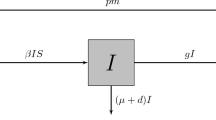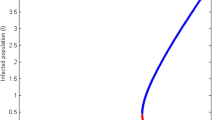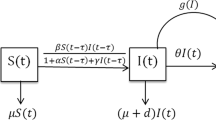Abstract
This paper investigates an SIR model with nonlinear state-dependent feedback control. The saturation incidence rate is introduced into the classical SIR model, and the specific expression of the equilibrium point of the model without pulse control is derived, and the stability of the equilibrium point is analyzed. When the number of susceptible individuals reaches a threshold \(S_{h}\), comprehensive prevention and control strategies such as treatment, isolation, and vaccination will be implemented. The existence and global stability of the disease-free periodic solution (DFPS) of the model with state-dependent feedback control are discussed, and the properties of the Poincaré map are analyzed. Based on the bifurcation theory related to a one-parameter family of maps associated with the Poincaré map, we define the control reproduction number \(R_{c}\) based on different parameters and observe the effect of these parameters on bifurcation. Numerical simulations show that transcritical and pitchfork bifurcations, as well as backward bifurcations, may occur under certain conditions. Additionally, a sensitivity analysis of \(R_{c}\) is conducted, and the optimal control strategy for the SIR model without pulse control is discussed. These results can provide some suggestions for virus control and vaccine production, among other issues.









Similar content being viewed by others
Data availability
Data sharing not applicable to this article.
References
V. Capasso, G. Serio, A generalization of the Kermack–McKendrick deterministic epidemic model. Math. Biosci. 42(1), 43–61 (1978)
B. Shulgin, L. Stone, Z. Agur, Pulse vaccination strategy in the SIR epidemic model. Bull. Math. Biol. 60(6), 1123–1148 (1998)
S.J. Gao, L.S. Chen, J.J. Nieto, A. Torres, Analysis of a delayed epidemic model with pulse vaccination and saturation incidence. Vaccine 24(35–36), 6037–6045 (2006)
S.J. Gao, L.S. Chen, Z.D. Teng, Impulsive vaccination of an SEIRS model with time delay and varying total population size. Bull. Math. Biol. 69(2), 731–745 (2007)
A. D’Onofrio, Stability properties of pulse vaccination strategy in SEIR epidemic model. Math. Biosci. 179(1), 57–72 (2002)
F.C. Kong, J.J. Nieto, Impact of discontinuous treatments on the generalized epidemic model. Topol. Methods Nonlinear Anal. 56(1), 349–378 (2020)
I. Area, F.J. Fernández, J.J. Nieto, F.A.F. Tojo, Concept and solution of digital twin based on a stieltjes differential equation. Math. Methods Appl. Sci. 45(12), 7451–7465 (2022)
R.J. Smith, E.J. Schwartz, Predicting the potential impact of a cytotoxic Tlymphocyte HIV vaccine: how often should you vaccinate and how strong should the vaccine be? Math. Biosci. 212(2), 180–187 (2008)
J.C. Panetta, A mathematical model of periodically pulsed chemotherapy: tumor recurrence and metastasis in a competitive environment. Bull. Math. Biol. 58(3), 425–447 (1996)
J.C. Panetta, A mathematical model of drug resistance: heterogeneous tumors. Math. Biosci. 147(1), 41–61 (1998)
S. Bunimovich-Mendrazitsky, H. Byrne, L. Stone, Mathematical model of pulsed immunotherapy for superficial bladder cancer. Bull. Math. Biol. 70(7), 2055–2076 (2008)
T.Y. Cheng, S.Y. Tang, R.A. Cheke, Threshold dynamics and bifurcation of a state-dependent feedback nonlinear control SIR model. J. Comput. Nonlinear Dyn. 14(7), 071001 (2019)
S.Y. Tang, R.A. Cheke, State-dependent impulsive models of integrated pest management (IPM) strategies and their dynamic consequences. J. Math. Biol. 50(3), 257–292 (2005)
S.Y. Tang, Y.N. Xiao, L.S. Chen, R.A. Cheke, Integrated pest management models and their dynamical behaviour. Bull. Math. Biol. 67(1), 115–135 (2005)
S.Y. Tang, B. Tang, A.L. Wang, Y.N. Xiao, Holling-II predator-prey impulsive semi-dynamic model with complex Poincaré map. Nonlinear Dyn. 81(3), 1575–1596 (2015)
S.Y. Tang, W.H. Pang, On the continuity of the function describing the times of meeting impulsive set and its application. Math. Biosci. Eng. 14(5–6), 1399–1406 (2017)
J.H. Liang, S.Y. Tang, J.J. Nieto, R.A. Cheke, Analytical methods for detecting pesticide switches with evolution of pesticide resistance. Math. Biosci. 245(2), 249–257 (2013)
T.Y. Wang, Microbial insecticide model and homoclinic bifurcation of impulsive control system. Int. J. Biomath. 14(6), 2150043 (2021)
S.Y. Tang, Y.N. Xiao, R.A. Cheke, Multiple attractors of host-parasitoid models with integrated pest management strategies: Eradication, persistence and outbreak. Theor. Popul. Biol. 73(2), 181–197 (2008)
S.Y. Tang, J.H. Liang, Y.S. Tan, R.A. Cheke, Threshold conditions for integrated pest management models with pesticides that have residual effects. J. Math. Biol. 66(1–2), 1–35 (2013)
Y.Q. Liu, X.Y. Li, Dynamics of a discrete predator-prey model with Holling-II functional response. Int. J. Biomath. 14(8), 2150068 (2021)
J. Xu, M.Z. Huang, X.Y. Song, Dynamical analysis of a two-species competitive system with state feedback impulsive control. Int. J. Biomath. 13(05), 2050007 (2020)
S.Y. Tang, R.A. Cheke, Models for integrated pest control and their biological implications. Math. Biosci. 215(1), 115–125 (2008)
Y. Tian, Y. Gao, K. Sun, Qualitative analysis of exponential power rate fishery model and complex dynamics guided by a discontinuous weighted fishing strategy. Commun. Nonlinear Sci. 118, 107011 (2023)
Y. Tian, C. Li, J. Liu, Complex dynamics and optimal harvesting strategy of competitive harvesting models with interval-valued imprecise parameters. Chaos Soliton Fractal 167, 113084 (2023)
Y. Tian, Y. Gao, K. Sun, A fishery predator-prey model with anti-predator behavior and complex dynamics induced by weighted fishing strategies. Math. Biosci. Eng. 20(2), 1558–1579 (2023)
H. Li, Y. Tian, Dynamic behavior analysis of a feedback control predator-prey model with exponential fear effect and hassell-varley functional response. J. Frankl. Inst. 360(4), 3479–3498 (2023)
Y. Tian, Y. Gao, K. Sun, Global dynamics analysis of instantaneous harvest fishery model guided by weighted escapement strategy. Chaos Soliton Fractal 164, 112597 (2022)
N.M. Ferguson, D.A. Cummings, S. Cauchemez, C. Fraser, S. Riley, A. Meeyai, S. Iamsirithaworn, D.S. Burke, Strategies for containing an emerging influenza pandemic in Southeast Asia. Nature 437(7056), 209–214 (2005)
...C. Fraser, C.A. Donnelly, S. Cauchemez, W.P. Hanage, M.D.V. Kerkhove, T.D. Hollingsworth, J. Griffin, R.F. Baggaley, H.E. Jenkins, E.J. Lyons, T. Jombart, W.R. Hinsley, N.C. Grassly, F. Balloux, A.C. Ghani, N.M. Ferguson, A. Rambaut, O.G. Pybus, H. Lopez-Gatell, C.M. Alpuche-Aranda, I.B. Chapela, E.P. Zavala, D.M.E. Guevara, F. Checchi, E. Garcia, S. Hugonnet, C. Roth, Pandemic potential of a strain of influenza A (H1N1): early findings. Science 324(5934), 1557–1561 (2009)
S.Y. Tang, Y.N. Xiao, Y. Lin, R.A. Cheke, J.H. Wu, Campus quarantine (Fengxiao) for curbing emergent infectious diseases: lessons from mitigating A/H1N1 in Xi’an, China. J. Theor. Biol. 295, 47–58 (2012)
Y.N. Xiao, S.Y. Tang, J.H. Wu, Media impact switching surface during an infectious disease outbreak. Sci. Rep. 5, 7838 (2015)
W.H. Fleming, R.W. Rishel, Deterministic and stochastic optimal control. Adv. Math. 1, 222 (1976)
D.L. Lukes, Differential Equations: Classical to Controlled, Mathematics in Science and Engineering (Academic Press, New York, 1982), p.162
L.S. Pontryagin, V.G. Boltyanskii, R.V. Gamkrelidze, E.F. Mishchenko, The mathematical theory of optimal processes. Bell Syst. Tech. J. 27, 623–656 (1986)
D.M. Xiao, S.G. Ruan, Global analysis of an epidemic model with nonmonotone incidence rate. Math. Biosci. 208(2), 419–429 (2007)
W.M. Liu, S.A. Levin, Y. Lwasa, Influence of nonlinear incidence rates upon the behavior of SIRS epidemiological models. J. Math. Biol. 23(2), 187–204 (1986)
W.M. Liu, H.W. Hethcote, S.A. Levin, Dynamical behavior of epidemiological models with nonlinear incidence rates. J. Math. Biol. 25(4), 359–380 (1987)
C.X. Liu, R.H. Cui, Qualitative analysis on an SIRS reaction-diffusion epidemic model with saturation infection mechanism. Nonlinear Anal. Real 62, 103364 (2021)
C.X. Liu, R.H. Cui, Analysis on a diffusive SIRS epidemic model with logistic source and saturated incidence rate. Discret. Contin. Dyn. B 28(5), 2960–2980 (2023)
E. Avila-Vales, G.E. Garcia-Almeida, A.G.C. Perez, Qualitative analysis of a diffusive SIR epidemic model with saturated incidence rate in a heterogeneous environment. J. Math. Anal. Appl. 503(1), 125295 (2021)
Acknowledgements
This work is supported by the National Natural Science Foundation of China (no. 12171193, 12071407).
Author information
Authors and Affiliations
Corresponding author
Ethics declarations
Conflict of interest
The authors declare no competing interest.
Rights and permissions
Springer Nature or its licensor (e.g. a society or other partner) holds exclusive rights to this article under a publishing agreement with the author(s) or other rightsholder(s); author self-archiving of the accepted manuscript version of this article is solely governed by the terms of such publishing agreement and applicable law.
About this article
Cite this article
Li, Y., Huang, S. & Song, X. Global dynamic analysis of a nonlinear state-dependent feedback control SIR model with saturation incidence. Eur. Phys. J. Plus 138, 636 (2023). https://doi.org/10.1140/epjp/s13360-023-04277-7
Received:
Accepted:
Published:
DOI: https://doi.org/10.1140/epjp/s13360-023-04277-7




